Last week’s post revolved around finding a box of old hearing aids in my garage, and wondering if any of them were interesting or rare enough that information and photographs of them should be documented.
I found some really good “stuff” and wrote about some unusual hearing aids that I had found in the box. That post focused on some of the early eyeglass hearing aids and where they fit into the historical development of hearing aids. I ended by saying that this week’s post would continue this historical trend, but would focus primarily on the origins of the first BTE hearing aids.
BTE Hearing Aids
Behind-the-ear (BTE) hearing aids dominated the hearing aid market during the 1960s and 1970s (with a resurgence in the late 1990s and continuing until now). Transistors, replacing the vacuum tubes as amplifiers, allowed substantial, but not all, of the miniaturization that occurred in just a very short time following their use in hearing aids, and allowed smaller devices that could be fitted where they belonged – at the ear level.
The change in size reduction was limited somewhat in the early days because microphones and receivers were still rather large. Adding to the size during this evolutionary period was that most of the components – transistors, resistors, capacitors, switches, etc. were connected via soldered hard wire.
BTE Early Phases
In the late 1950s, BTE hearing aids were developed in essentially a two-event progression. The first phase involved the use of an external receiver coupled to an earmold to deliver sound to the ear. A second phase in this historical development incorporated all of the hearing aid components into a single case, including the receiver.
BTE With External Receiver
Zenith “Diplomat” (1956)
This hearing aid was among the first to be considered a true BTE hearing aid. During this phase, BTE hearing aids consisted of a processor that fit behind the ear (auricle), and had a hard-wired connection to an external receiver that snapped to an earmold in the ear. In other words, manufacturers took the concept of small body-worn and barrette-style hearing aids that used external receivers, and attempted to implement them at the ear level without lengthy connecting cords (Figure 1).
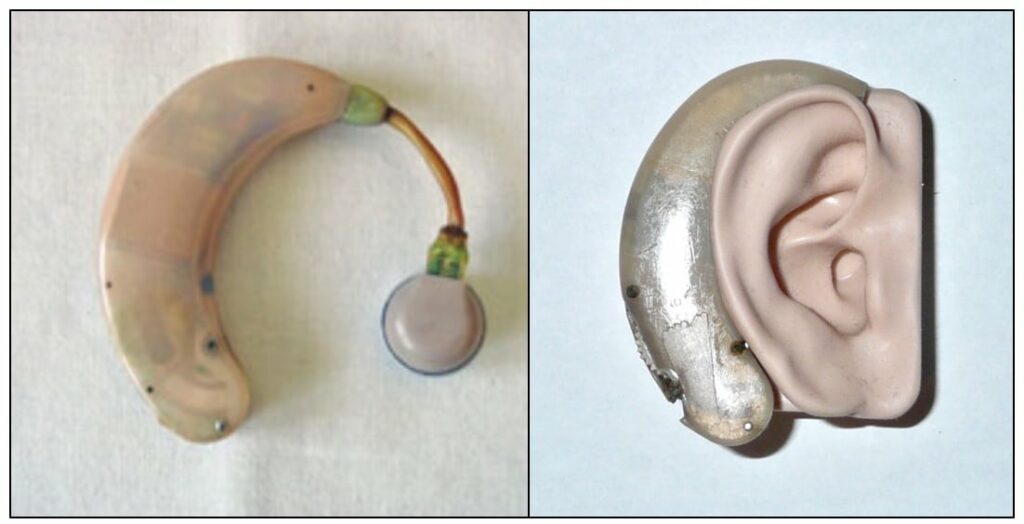
Figure 1. Zenith “Diplomat” hearing aid developed in 1956. It covered the entire area behind the auricle, from top to bottom (and a little beyond), as shown in the right image. The right image does not show the external receiver.
The Zenith Diplomat Behind-the-Ear hearing aid is considered by many to be the first true BTE hearing aid – something that actually was designed to fit behind the ear. It was made by the Zenith Radio Corporation, used four transistors, and had an external receiver. The case measured 64 x 19 x 11 mm and weighed 15 grams. It came in flesh or light gray color. It was often referred to as the “Banana” because of its large size. It used a No. 675 mercury battery. The model from my collection had seen better days as can be seen in Figure 1 on the right side, and no longer had the external receiver that could be unplugged from the hearing aid (a 1957 improvement), not just from the receiver (this feature was a first). In 1959 Zenith introduced the “Diplomat 5” which had a similar appearance, including an external receiver, but used a magnetic microphone and was slightly smaller (56 x 16 x 10 mm but also with a weight of 15 grams). I do have this complete unit, but loaned it to someone for patent work and it has not yet been returned. It had a microphone opening on both sides and was powered by a 675 mercury cell. It came in a peach or gray case.
What a Difference a Year Made
BTE development moved along rapidly. This can be evidenced as seen in Figure 2, showing receiver BTE hearing aids in 1956 (Zenith Diplomat) and 1957 (Dahlberg Magic Ear II).
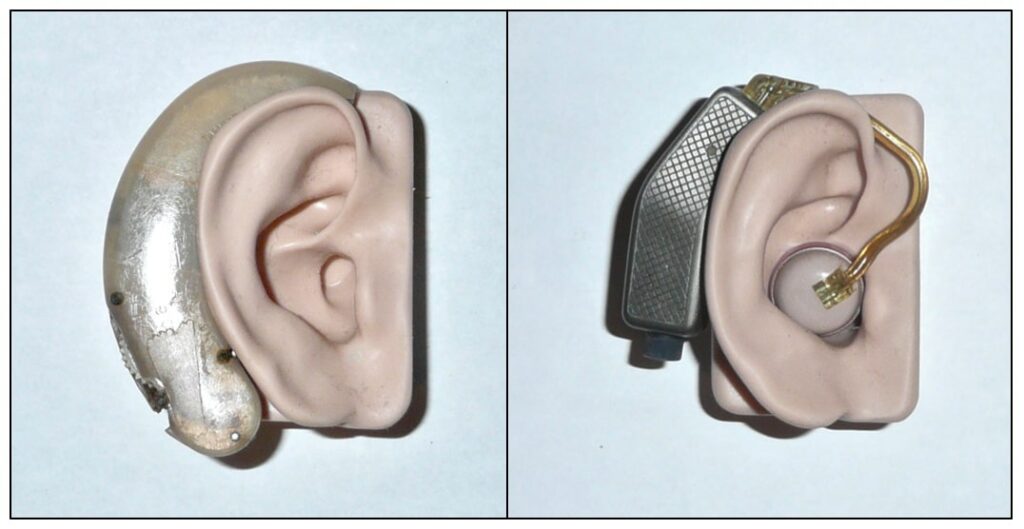
Figure 2. Zenith Diplomat introduced in 1956 (left aid), and the Dahlberg Magic Ear II introduced in 1957 (right aid). The size reduction in one year was rather remarkable. The Dahlberg aid would fit better on the ear had I chosen to reshape/change the receiver linkage. However, I try not to make any changes on any of the aids in my collection.
Dahlberg Magic Ear II (1957)

Figure 3. The Dahlberg Magic Ear II, a behind-the-ear hearing aid having an external receiver. The case was composed of two different materials. The outer shell was made of metal and the inner surface was a hard plastic. It is speculated that this was done to prevent moisture penetration and rust prevention.
This was a BTE hearing aid having an external receiver. It had 4 transistors, used a 400 size cell, and came in separate right and left ear models because the body had a small outward bend at the mastoid bone to better fit behind the ear. The receiver could disconnect from the processor as well as from the receiver, and the volume control was a round knob at the bottom of the hearing aid. It was 43 x 13 x 10 mm and weighed 10 grams. The case was fabricated of two different materials (Figure 3). The outside was metal and the inside surface was plastic. It was during this time period that many BTE hearing aids were made with metal cases.
BTE Without External Receiver
BTE hearing aids that had all components fully integrated in the hearing aid case was the next logical progression in BTE evolution. These hearing aids had no external receiver, but instead incorporated the receiver into the case along with all the other components. As might be expected, including the receiver into the case had the effect of enlarging the BTE hearing aid, at least in the early stages, making it larger than BTE hearing aids having an external receiver.
Maico AG (1957)
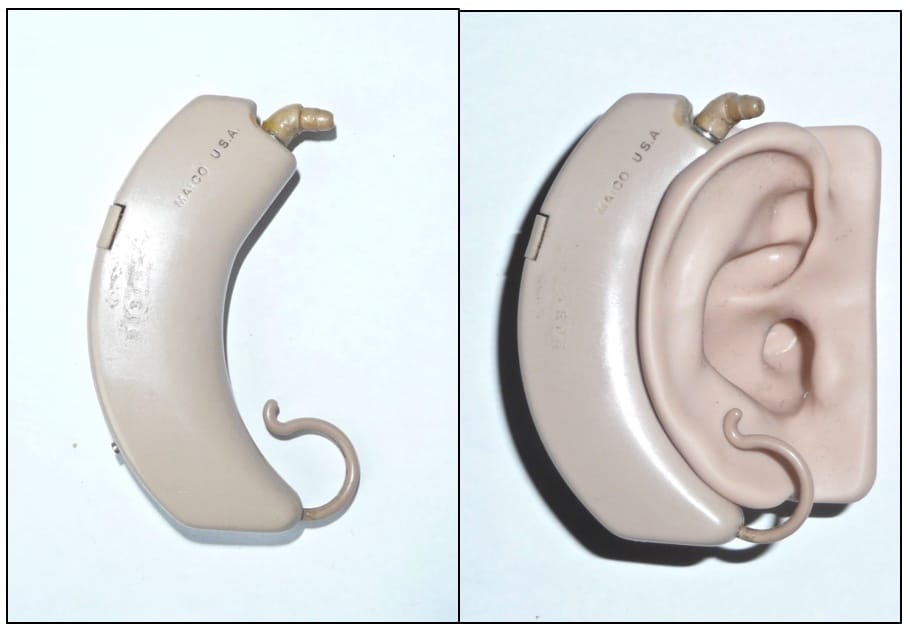
Figure 4. The Maico AG BTE hearing aid having all the components, including the receiver, housed within the case, and showing how it fit individuals. In the images shown in Figure 4, the tubing from the sound outlet nozzle (top extension) to the earmold in the ear, is missing.
This was a three transistor BTE hearing aid that had a lower front hook to hold the hearing aid onto the ear (Figure 4). All components, including the receiver, were incorporated into the plastic case. The aid was powered by a 675 cell. Rough dimensions were 64 x 19 x 14 mm, and the device weighed 19 grams. Weight was measure minus the battery. The volume control was on the bottom and the microphone opening on the back side. It had a two-position switch on the lower back side above the volume control. The outside of the case was metal, and the inside, plastic. Referring to this as a BTE reminds me of the joke: How many elephants can you put in a Volkswagen? Answer: two in the front and two in the back. Interesting, when no constraints are provided.
Sonotone 333 (1957)
This BTE instrument was all metal, and of an unusual shape. It was a 4-transistor hearing aid operated by a 400 cell. Its size was 32 x 21 x 13 mm and weighed 16 grams. The aid was designed to hang over the top part of the auricle (Figure 5). It fit either ear. The battery is under the flap-looking structure between the neck and body of the aid. The microphone opening is the slit at the bottom, just above the Sonotone name and model number.
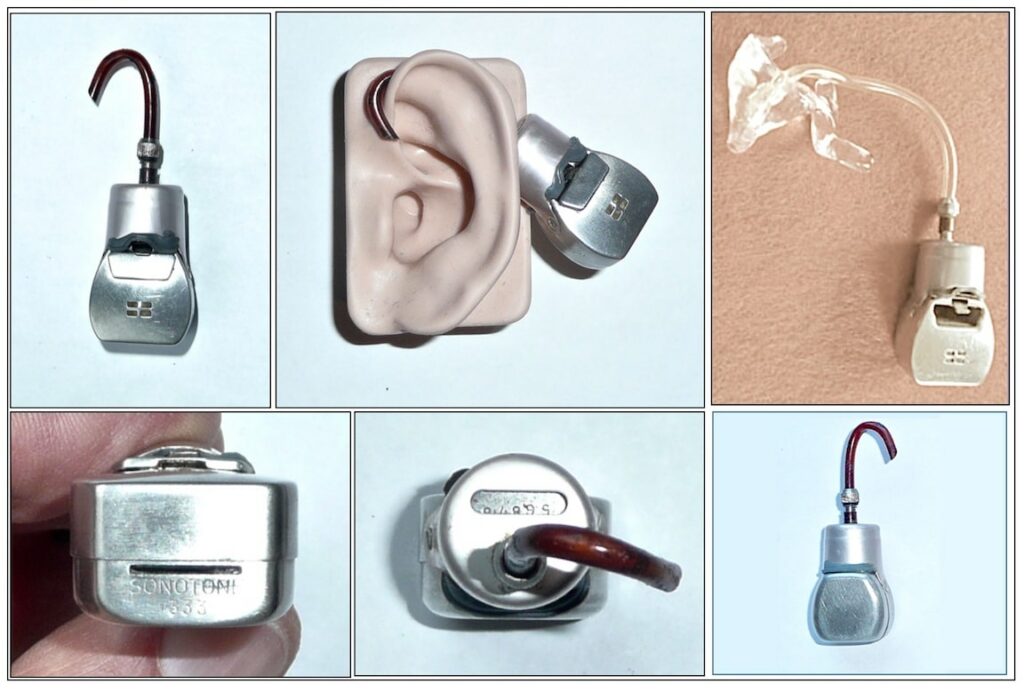
Figure 5. The Sonotone 333 BTE hearing aid. All the components were housed in a metal case. With a longer tubing than shown, the aid would hang down below and behind the lower part of the auricle, not pushed out as shown in the upper center photo. That photo is used primarily to gauge the size. The body was narrower in one dimension than the other, and when fitted with the narrow dimension against the skull, slightly limited the protrusion of the auricle caused by the aid. Again, I did not want to change any of the parts of the aid, including the tubing to the ear. The upper right image shows how it would be attached to an earmold. That image has the batter locker removed. It is held in place by the small latch above the battery compartment opening.
Beltone Minuet (1958)
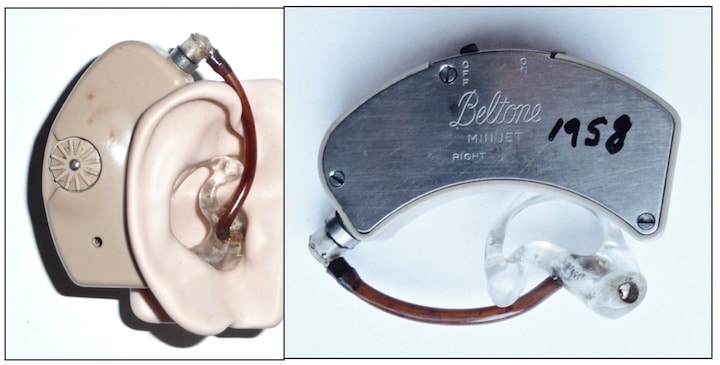
Figure 6. The Beltone “Minuet” BTE hearing aid. The unit shown is for the right ear (“Right” imprinted into the inner metal plate). It had a large volume control and a separate ON/OFF switch. The microphone opening is in on the lower, outer surface.
The Beltone Minuet was a 3-transistor behind-the-ear hearing aid. It was powered by a 400 cell, had a flesh or gray plastic outer surface and a metal back, and was available as both a right and left side configuration (Figure 6). It measured 54 x 19 x 11 mm. All components were housed in the case, including the receiver.
Acousticon “Privat-Ear A600” (1958)
Figure 7. The Acousticon “Privat-Ear” A600 is shown front (left) and back (right). The case is made of metal, both sides. The Acousticon name and model number are shown at the top (right image). The serial number is stamped into the area near the sound tube (right image).
The Acousticon A600 BTE hearing aid was a 3-transistor unit powered by a 675 cell. The entire case was metal, with dimensions of 48 x 16 x 10 mm, and weighing 17 grams (Figure 7). The battery compartment was beneath a metal cover having a slightly-elevated slide knob to open. Additionally, a removable, washer-like inner seal covered the edges of the battery and the battery compartment cover edges to prevent moisture and debris from interfering with power performance.
Next week’s post will look at some of the early in-the-ear hearing aids.
Wayne Staab, PhD, is an internationally recognized authority in hearing aids. As President of Dr. Wayne J. Staab and Associates, he is engaged in consulting, research, development, manufacturing, education, and marketing projects related to hearing. His professional career has included University teaching, hearing clinic work, hearing aid company management and sales, and extensive work with engineering in developing and bringing new technology and products to the discipline of hearing. This varied background allows him to couple manufacturing and business with the science of acoustics to bring innovative developments and insights to our discipline. Dr. Staab has authored numerous books, chapters, and articles related to hearing aids and their fitting, and is an internationally-requested presenter. He is a past President and past Executive Director of the American Auditory Society and a retired Fellow of the International Collegium of Rehabilitative Audiology.
**this piece has been updated for clarity. It originally published on September 19, 2017








Thanks Wayne! Nice trip down memory lane for me & remembering some of my old aids from “60s & ’70s. Plus, remembering Ken Berger’s book on the history of hearing aids.
Ah yes, I remember most of them and thanks. I gave my collection to Oticon.
Thanks for the memories!
Dick
Great, thank you for sharing! Really interesting to see these older products…